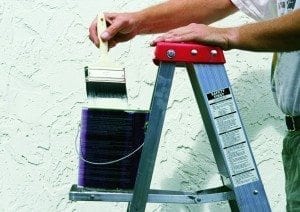
6 tips from professional painters
How to improve paint flow
When painting, pre-moisten your brush or roller with whatever liquid is used in the paint (water for latex, mineral spirits for oil-based). Wring/shake out excess and then apply paint. This will improve paint flow and make that perfect finish easier to attain.
Spray adhesive for masking paint jobs
For those areas where wind and moisture make it hard for adhesive tape to stay in place when masking off areas you want to keep clean, I recommend spray adhesive. It creates a stronger bond and prevents the tape from lifting when painting over it with a spray gun. Use the adhesive in small amounts and test the surface first, as spray adhesive will stain certain surfaces. I highly recommend this tip for painters, stucco applicators, cement and general construction specialists. –By Jonathan A., Santa Ana, California
Perfect PVC paint jobs
Before painting trim, moldings and other building components manufactured with PVC, sand them lightly with a piece of very fine grit sandpaper. Pay special attention to any shiny spots and make sure you dull the finish. This will result in better paint adhesion and help create a beautiful, long-lasting paint job. –By Raúl D., Lilburn, Georgia

Paint will not adhere to damp stucco. It may look okay initially, but after the first rainfall, the paint will lift from the surface. The stucco repair must be completely dry.
Before you paint over stucco
Paint will not adhere to damp stucco. It may look okay initially, but after the first rainfall, the paint will lift from the surface. The stucco repair must be completely dry.
Oil-based or latex paint?
When you’re not sure if the surface you are re-painting has oil-based or latex paint on it, dab a cotton ball or cotton swab in rubbing alcohol and lightly rub the cotton over the surface to be painted for a few seconds. If a paint film comes off on the cotton, the paint is latex. If the cotton is clean, the paint is oil-based.
Streaks, water-spotting or weeping
When streaks, water-spotting or weeping appear in a paint job, it may be due to surfactant leaching. Exterior latex paints contain some waterborne ingredients. If the paint is applied in cool, humid conditions that retard drying, a large proportion of these ingredients can migrate to the surface of the paint as it dries, or shortly thereafter. They typically appear as shiny streaks or blotches. To minimize the possibility of surfactant leaching, avoid painting late in the day, especially in the spring and fall.

